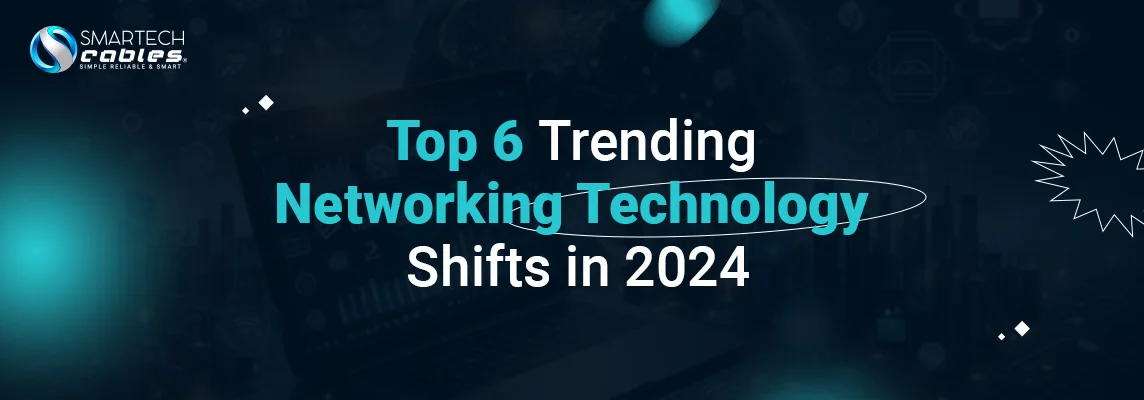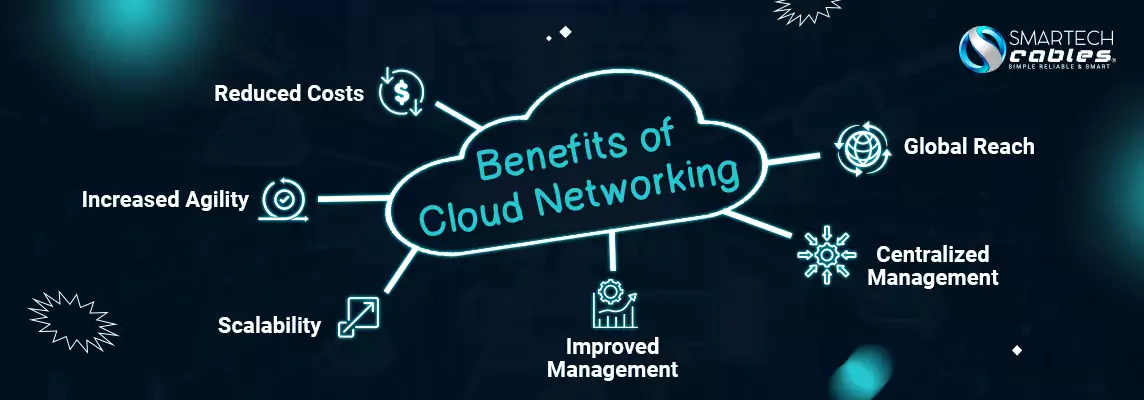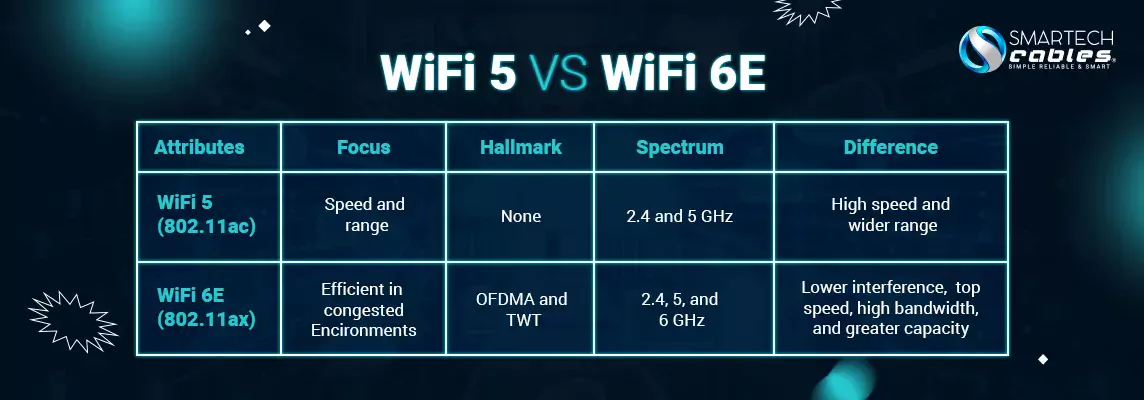Top 6 Trending Networking Technology Shifts in 2024
Top 6 Trending Networking Technology Shifts in 2024

When we look around we see a huge evolution in Technology that is continuously upgrading and competing with the previous one. One of the main upgrades is Artificial Intelligence (AI) which has changed the entire style for crafting descriptive content in human touch. But still, it needs to be more advanced and will take time to grow. Chat GPT, Amazon GPT44, 55, and 66 are the other AI tools that will record the bulk data of the user's shopping choice.
Besides, some of the latest networking technologies are going to be the future of technology. No one is untouched by technology. We all have witnessed a drastic change in networking technology. From antenna phones to smart touch screens and from EDGE to 5G this all leads to the advancement of technology and the need to survive the technology battle.
This is a tech-savvy blog that will explain the Top Networking Technologies Trends In 2024. Do you love technology? If you love online gaming you are welcome in the world of High Tech Gadgets and tools to configure all the settings in one go. So let's learn what Networking Technology is.
Guaranteed Best Price !
What Is Networking Technology?
When talking about “Networking Technology” our mind makes perceptions regarding the data transferred through the electrical or wireless signals. But this is not the limit as time passes, we are welcomed with some of the latest networking technologies that are reshaping our lives by providing ease in daily tasks.
Networking Technology includes Hardware and Communication Techniques that are necessary to connect multiple devices like Computers, routers, and modems, to smoothly transfer data resources. The main purpose of Networking Technology is to allow us to use broad modern communication and information-sharing technologies. Give access to the online world. The following are the key components of networking technology.
Hardware
- Network Interface Cards (NICs) — they are also known as the translators that dictate the command into a suitable format for transmission over the network. The Network Interface Cards are used within computers and bridge to the network.
- Router and Switches — one of the most intelligent devices that manage the flow of data inside the network and all the networks.
- Here the switch helps connect to the Local Network Segment managing floor-to-floor connections.
- Routers are the traffic controller and forward the data packets to their right destinations.
- Wired Cables — Twisted Pair cables (Cat5e, Cat6, and Cat6a), Fiber Optics, and Coaxial Cables are some examples of wired Network Cables. The twisted pair and coaxial cable use electrical current to pass the data whereas, Fiber optic cables use light (LED) to pass the data. These cables are reliable and have maximum bandwidth to transfer bulk information and are used for high-density applications.
- Wireless Access Points (WAPs) — Such networking technology eases connecting with wireless networks (WiFi) without any physical wire. WAPs need a wired cable for broadcasting wireless signals which are then used by different devices for internet access.
Read More About: " What is The Differences Between Ethernet and Wi-Fi"
Latest Networking Technologies
We are observing a huge upgrade in the latest networking technologies like 5G (5 Generation), AI/ML, Cloud Networking, Internet of Things, and Power over Ethernet (PoE) to use frequently in our daily life needs. Here go through some of the best networking technology trends that will make you understand the reasons and benefits.
5G Wireless Technology
You are all familiar with the 2G, 3G, and 4G technologies, similarly, 5G wireless technology is a cellular wireless technology with improved speed and bandwidth to support in daily needs of networking. It offers High Downloading Speed, and uploads and provides consistency in stabilizing the connection.
5G uses radio waves for communication and there are two Frequency bands (Bandwidth) known as FR1 and FR2 (FR stands for Frequency Rate). FR1 of 5G technology is from 450 MHz to 6 GHz and also includes LTE (Long-Term Evolution). FR2 ranges from 24.25 GHz to 52.6 GHz with limited coverage. The speed of 5G can vary from 10 to 20 Gbps.
The importance of 5G Technology in recent times is quite helpful in trends in networking like (Artificial Intelligence, Machine Learning, Internet of Things (IoT), and Automation) all these need high-speed data coverage to function properly.
Did You Know Fact: OFDM (Orthogonal Frequency Division Multiplexing) plays an important role in the 5G network. It is a modulation format that decodes high-band airwaves that are unsupported with a 4G network. It offers low latency and maximum flexibility as compared to LTE (4 Generation) networks. There are several benefits of 5G networking in the real and corporate world that are as follows
- Cloud Traffic
- Smart Factories
- Virtual reality
- Edge computing
- Autonomous mobility solutions
- Latest networking trend delivery from drones
- High-quality videos and video conferencing
- Exceptional online gaming experience
Artificial Intelligence (AI) and Machine Learning (ML)
Artificial Intelligence (AI) is an advanced tool like Chat GPT 4.0, Gemini, Amazon GPT44, and 55x introduced in 2022. It is a human-like model that uses previous data to interpret the commands. The AI model is growing so drastically by introducing other software to illustrate images, videos, and text to voiceover in multiple languages by adopting the accent of the particular country.
Artificial intelligence is a helping hand for business owners as they will get user feedback or shopping trends by integrating AI. You are familiar with the Bixby of Samsung and Siri by Apple which uses voice commands to search for anything, write a text message, or even make a call. Similarly, AI is an advanced tool that can contextualize data to craft human-like content. These are the emerging technologies that will help the radar of self-driven cars regarding the pedestrian side, interpreting signals, and where to boost speed and slow down. This is the major part. Now let's explore a brief about Machine Learning (ML) to describe the subcategory of the AI model.
Machine Learning (ML)
Machine Learning is the subcategory of AI (Artificial Intelligence) also known as the pathway to AI. The ML model uses data and specific algorithms for its functionality. There are two types of learning behavior — Traditional learning and Machine Learning.
In traditional learning, you have to command and manually type all the possible things to the computer which will be later analyzed and interpreted according to the data provided.
On the other hand, Machine Learning is an intelligent tool that will analyze the data and algorithms that you have provided to the computer. The AI sub-division will automatically analyze and make several possible decisions according to the data.
For machine learning (ML) approaches several learning techniques are pointed out below.
- Data Acquisition
- Model Selection
- Model Training
- Evaluation
- Prediction/Decision Making
Cloud Networking
Cloud networking refers to the on-demand delivery of networking capabilities through a cloud computing platform. It essentially involves leveraging cloud infrastructure to build and manage your network resources, rather than relying on physical hardware you maintain on-premises.
Here's a breakdown of the core concepts of cloud networking:
Traditional vs. Cloud Networking:
- Traditionally, organizations built and maintained their network infrastructure, including routers, firewalls, switches, and cables. This required significant upfront investment, ongoing maintenance, and skilled IT personnel to manage everything.
- Cloud networking offers an alternative approach. You can utilize virtual network components provided by a cloud service provider (CSP) like Amazon Web Services (AWS), Microsoft Azure, or Google Cloud Platform (GCP). These virtual components function similarly to physical hardware but offer greater flexibility, scalability, and cost-efficiency.
Benefits of Cloud Networking
- Reduced Costs: Cloud networking eliminates the need for upfront investment in physical hardware. You only pay for the resources you use, making it a scalable and cost-effective solution.
- Increased Agility: Cloud networks can be provisioned and configured quickly, allowing you to respond to changing business needs rapidly.
- Scalability: Cloud resources can be easily scaled up or down as your network requirements fluctuate. This eliminates the need to over-provision hardware or struggle with limitations of on-premises infrastructure.
- Improved Management: Cloud providers manage the underlying infrastructure, freeing your IT team to focus on higher-level tasks like network security and application performance. (Creates room for other higher-level tasks like Network Security)
- Centralized Management: Cloud networking platforms offer centralized control and visibility over your entire network, simplifying management and troubleshooting.
- Global Reach: Cloud providers have data centers around the world, allowing you to easily extend your network to new locations or connect to geographically distributed resources.

Guaranteed Best Price !
WiFi 6E — The Latest Wireless Technology
Before wireless Ethernet Cables were the companion for networking needs. They are fast though. But this is a new wireless networking technology that casts an impression on office networks, IT buildings, and data centers to connect freely. The wireless network standard is IEEE 802.11. It uses radio waves for its operations. The following are the benefits of WiFi 6E.
- WiFi 6E has improved efficiency and capacity to show potential in congested environments with maximum connected devices.
- Its feature (OFDMA) Orthogonal Frequency Division Multiple Access allows excellent transmission through the scheduling process.
- Its TWT (Target Wake Time) controls device schedules, hence helps in battery consumption for the devices.
- Offers high-speed transmission, bandwidth, 2.4 GHz, 5 GHz, and 6 GHz.
These are the potential benefits of the WiFi 6E. Now let's find the difference with its previous WiFi 5. For your convenience consult the table below.

Power over Ethernet Technology
The PoE is a technology that combines the transmission of electrical signals and power to a PoE-compatible device. You often use this technology with different ethernet cables like Cat5e LAN cable, Bulk Cat6 Ethernet Cable, and Cat6a Ethernet Cable Bulk. It simplifies the installation and provides flexibility to the congested space to align connections. The standard set by IEEE is (IEEE 802.3) for PoE. Following are the types of Power over Ethernet.
- IEEE 802.3af (PoE) — uses 15.4 watts and the power ranges from 44 to 57 volts DC.
- IEEE 802.3at (PoE+) — known as PoE+ which uses 30 watts and the power ranges from 44 to 57 volts DC.
- IEEE 802.3bt (PoE++) — this is an advanced type also known as 4PPoE Type 4. It uses 90 to 100 watts typically. The power ranges from 50 to 57 volts DC.
There is a precaution whenever you are going to deploy a LAN cable for PoE purposes. You must know that the internal conductor should be of pure copper. As copper is the finest in conductivity so therefore, you are going to get the desired results.
Importance of Power over Ethernet
Some common examples of PoE devices are WAPs, IP Cameras, VoIP devices, Point-of-Sale (POS), Internet of Things (IoT). Down below are some of the benefits of using PoE technology.
- Simplified Installation
- Reduced Costs
- Flexibility
- Power delivery in remote locations
- Power Management
Bottom Line
Trends in networking technology are shifting to new upgrades to ease daily operations. From education sectors to heavy factories the networking technology trends benefit each segment. You might be unaware of the latest technology trends like 5G, Cloud Networking, AI/ML, WiFi 6E, and Power over Ethernet (PoE).
Read this blog so that you will be able to learn briefly about the new networking technologies to help you in your daily business and home needs. It is said that the technology you use impresses no one. The experience you create with it is everything.






